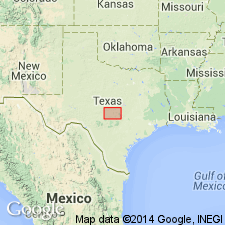
- Usage in publication:
-
- Seaman Ranch [member]
- Modifications:
-
- Named
- Dominant lithology:
-
- Shale
- Sandstone
- Limestone
- AAPG geologic province:
-
- Bend arch
Summary:
Named for a ranch in western Palo Pinto Co, TX on Bend arch, where "typically exposed." No type locality designated. Also called Seaman Ranch beds; is lowermost of two [members] of Brad formation of Canyon group (both revised) in Brazos River Valley area. In Colorado River Valley area Brad formation consists of (ascending): Cedarton shale, Clear Creek limestone, Placid shale, and Ranger limestone [members]. In the Brazos River Valley (to north) Brad formation consists of (ascending): Seaman Ranch beds [or member], and Ranger limestone [member]. The Seaman Ranch beds are equivalent to Placid shale, Clear Creek limestone, and Cedarton shale [members] of Colorado River area. Seaman Ranch beds have an average thickness of 150-200 ft and consist of a basal bed of shale 60-100 ft thick overlain by 50-110 ft of dark-gray, soft, sandy shale containing one or two lentils of reddish-brown sandstone and a thin layer or two of dark-brown limestone. In most places the shales are nonfossiliferous, although one or two localities offer very fossiliferous beds. Is Pennsylvanian in age. Measured sections. Correlation chart.
Source: GNU records (USGS DDS-6; Denver GNULEX).
For more information, please contact Nancy Stamm, Geologic Names Committee Secretary.
Asterisk (*) indicates published by U.S. Geological Survey authors.
"No current usage" (†) implies that a name has been abandoned or has fallen into disuse. Former usage and, if known, replacement name given in parentheses ( ).
Slash (/) indicates name conflicts with nomenclatural guidelines (CSN, 1933; ACSN, 1961, 1970; NACSN, 1983, 2005, 2021). May be explained within brackets ([ ]).

